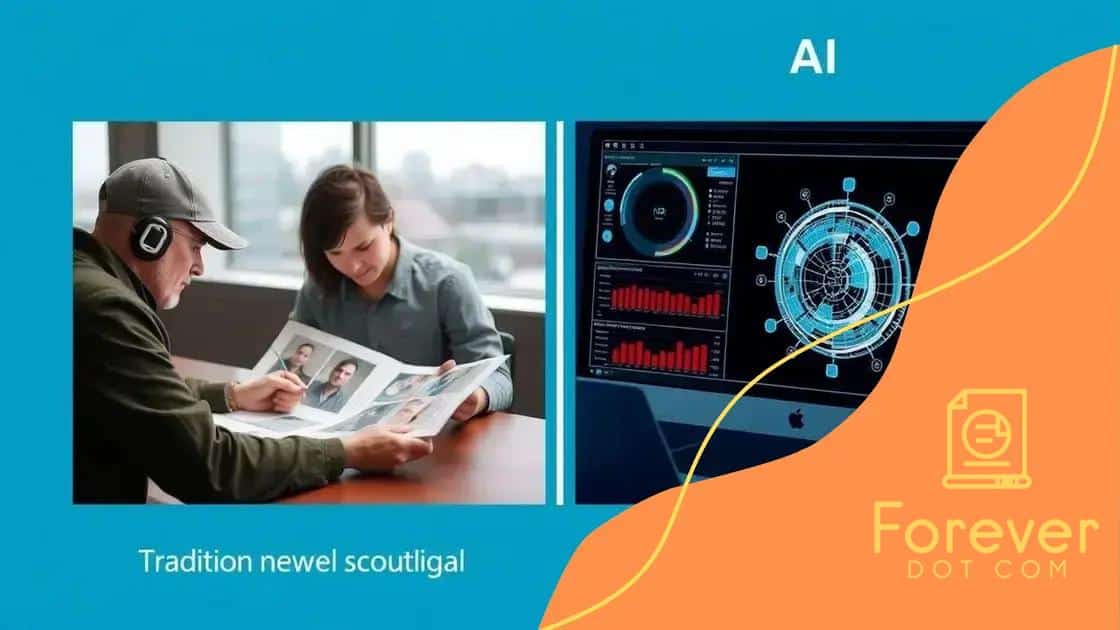How AI is transforming model scouting and selection

AI is transforming model scouting and selection by utilizing data-driven insights, enhancing personalization, and integrating advanced technologies like augmented reality and predictive analytics to streamline the decision-making process.
How AI is transforming model scouting and selection is reshaping industries by enhancing the decision-making process. Imagine having access to insights that can lead to better outcomes—curious how this works?
Understanding the impact of AI in model scouting
Understanding the changing landscape of scouting is essential. AI is not just a buzzword; it’s an impactful technology that revolutionizes how models are evaluated. With AI, model scouting gains more precision and efficiency.
The Advantages of AI in Model Scouting
When we think about scouting, it often involves a lot of guesswork. However, AI uses data analytics to make informed decisions. This results in:
- Faster evaluations: AI can analyze countless models quickly.
- Better predictions: Through machine learning, AI anticipates which models will succeed.
- Cost efficiency: Reducing time spent on traditional scouting cuts down expenses.
Furthermore, the technology learns and adapts over time. For instance, as AI absorbs more data, it fine-tunes its algorithms, leading to improved scouting outcomes.
Challenges and Considerations
While AI brings many benefits, there are challenges as well. It’s vital to monitor data integrity and ensure ethical practices. Balancing AI insights with human intuition can lead to the best decisions.
AI doesn’t replace human experience; rather, it enhances it. By combining data-driven insights with the creativity and intuition of scouts, we can achieve superior results. Overall, embracing AI in model scouting is a strategic move that can lead to success.
Key technologies driving AI efficiency
Key technologies are driving AI efficiency in model scouting. These advancements are essential for transforming how decisions are made in the industry.
Machine Learning Algorithms
Machine learning (ML) is crucial for processing large datasets quickly. By learning from past data, ML algorithms can predict outcomes more accurately. This allows scouts to focus on the most promising models.
- Predictive modeling: A common application that helps foresee trends.
- Pattern recognition: Identifies valuable traits in models.
- Automated evaluations: Reduces human bias and error.
As machines learn, they can adapt to new data trends, which enhances their analytical capabilities. This adaptability is a major asset for scouts and decision-makers.
Natural Language Processing (NLP)
Natural language processing plays a vital role in analyzing reviews and feedback about models. By interpreting human language, AI can draw insights from social media, interviews, and surveys. This information is invaluable in decision-making.
NLP allows for real-time sentiment analysis. Scouts can gauge public and industry responses quickly, allowing for timely adjustments. By integrating NLP, the scouting process becomes far more efficient and informed.
Computer Vision
Computer vision technology enables AI to analyze images and videos, allowing it to assess model appearances and presentations. This ability is transformative in scouting because it provides a detailed evaluation of physical attributes.
AI can automatically categorize features, such as facial expressions, body language, and style. This data helps scouts make more informed decisions about which models to pursue. By utilizing computer vision, agencies can greatly enhance efficiency.
Comparing traditional scouting methods with AI

Comparing traditional scouting methods with AI reveals a clear shift in how models are selected. Traditional scouting heavily relies on human intuition and experience, but AI introduces data-driven decision-making.
Speed and Efficiency
Traditional methods can be slow and labor-intensive. Scouting often involves attending numerous events and meetings. In contrast, AI can analyze thousands of models in just a few minutes. This rapid analysis means decisions can be made more swiftly.
- Algorithmic analysis: AI evaluates models based on predefined criteria, ensuring consistency.
- Automated screening: AI can filter out unfit candidates instantly.
- Instant feedback: Immediate data insights assist in refining choices.
This efficiency can lead to a more effective scouting process, allowing teams to focus on high-potential models rather than going through every option.
Data-Driven Insights
Traditional scouting often relies on qualitative assessments. Scouts may have personal biases that affect decisions. AI, however, leverages vast amounts of data to offer objective insights. This approach minimizes errors and enhances accuracy.
Data collected from social media, market trends, and previous performance feeds AI systems. As a result, the insights generated are more comprehensive and reliable. This leads to a more informed selection process.
Human Touch vs. Technology
While AI provides efficiency and analytical power, the human element remains crucial. Experienced scouts can still recognize unique traits that AI might overlook. Combining the human touch with AI’s efficiency creates a balanced approach.
For example, while AI can identify trends in data, experienced scouts can interpret those trends in the context of the fashion industry. This partnership can lead to more insightful decisions.
Real-life examples of AI in model selection
Real-life examples of AI in model selection showcase the practical benefits of incorporating technology into scouting. Companies across the fashion and modeling industries are utilizing AI to enhance their decision-making processes.
Major Brands Using AI
Several well-known brands have adopted AI for model selection, gaining a competitive edge. By analyzing various data points, these brands make informed choices about which models to feature.
- Fashion Nova: This brand employs AI to assess social media trends and influencer impact, ensuring that their model selections resonate with their target audience.
- Nike: AI helps Nike analyze athlete performance, allowing them to choose models who best represent their brand ethos and connect with consumers.
- Adidas: The company uses AI to understand customer preferences, guiding their model selection to align with market demands.
These examples illustrate how firms leverage AI to enhance their scouting efforts and improve their marketing strategies.
Data Analysis in Action
Multiple companies have implemented platforms that analyze vast amounts of data from past campaigns. For example, by tracking customer engagement with specific models, brands can determine future selections based on what resonates well with audiences.
The AI systems can identify high-performing models and patterns that emerge over time. This leads to smarter decisions based on actual data rather than intuition alone. As a result, brands experience increased sales and improved brand alignment.
Case Study: A Photographic Agency
A leading photographic agency incorporated AI to optimize their model selection process. The system evaluates model portfolios, presence on social media, and engagement metrics. By doing so, the agency can effortlessly shortlist candidates that fit specific client needs.
This approach has drastically reduced the time scouts spend on evaluations while enhancing the quality of their selections. It also allows scouts to focus on creative aspects, such as model suitability for specific themes or campaigns.
Future trends in AI and model scouting
Future trends in AI and model scouting indicate a dynamic shift in how models will be selected. As technology evolves, it will further enhance the effectiveness of scouting processes across the industry.
Enhanced Personalization
One significant trend is the move towards enhanced personalization. AI systems will analyze individual preferences and trends to create tailored scouting solutions. This means that models will be matched not just based on general criteria, but on specific market demands and audience interests.
- Customized scouting reports: AI can generate detailed reports tailored to unique brand requirements.
- Personalized model suggestions: Scouts will receive recommendations based on real-time data.
- Identifying niche markets: AI can uncover emerging trends in specific demographics.
This personalization will change how brands approach their model selection, ensuring they connect better with their consumers.
Integration of Augmented Reality (AR)
Augmented Reality (AR) is another exciting trend. AI will likely incorporate AR into scouting processes, allowing brands to visualize how models fit into digital environments. This immersive experience can help in making better decisions.
For example, scouts can use AR to see how a model looks in different styles and settings without a physical shoot. It can provide instant feedback on model suitability, making the process more efficient.
Predictive Analytics
Predictive analytics is set to become a game-changer in model scouting. By using historical data and current trends, AI can anticipate which models are likely to succeed in upcoming campaigns.
This ability to forecast outcomes will help brands make proactive decisions, minimizing risks associated with model selection. By understanding market shifts, brands can stay ahead of the curve and adjust their strategies accordingly.
Increased Collaboration
Collaborative efforts between AI systems and human scouts are expected to deepen. While AI can handle data analysis and pattern recognition, human creativity and intuition remain irreplaceable. This collaborative future will lead to more innovative scouting strategies.
As AI continues to evolve, it will empower scouts with more tools to enhance their work, allowing for a combination of data-driven insights and creative judgment.
FAQ – Frequently Asked Questions about AI in Model Scouting
How is AI improving model selection?
AI improves model selection by analyzing vast data sets quickly, providing insights that help brands make informed decisions.
What are the key benefits of using predictive analytics in scouting?
Predictive analytics helps identify which models are likely to succeed based on past data and trends, minimizing risks.
Can augmented reality (AR) enhance the modeling experience?
Yes, AR allows brands to visualize how models fit into different scenarios, improving the scouting process.
Why is collaboration between AI and human scouts important?
Collaboration ensures that AI’s data-driven insights are complemented by human intuition and creativity, leading to better scouting decisions.






